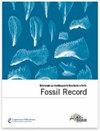下载PDF
{"title":"德国巴伐利亚州沙姆豪普滕晚侏罗世兽脚亚目Juravenator的大型半形鱼类伴侣","authors":"Gloria Arratia, Hans-Peter Schultze","doi":"10.1002/mmng.201200001","DOIUrl":null,"url":null,"abstract":"<p>A new neopterygian fish, <i>Voelklichthys comitatus</i> n. gen. n. sp., is described. The fish was found during the preparation of the theropod <i>Juravenator starki</i> Göhlich & Chiappe, 2006 in the same rock. The fish possesses numerous autapomorphies. The combination of autapomorphies is unique among Jurassic fishes and makes its taxonomic assignment difficult. The following characters are few examples demonstrating some of the peculiarities of the fish: The fish is small, oblong-shaped and has a large triangular head that is deeper than long; deepest point is at the level of the postparietal bone [parietal of traditional terminology] and the ventral end of the cleithrum. The skull roof is almost vertically oriented, with a strongly ossified and developed antero-dorsal orbital margin. Premaxilla and dentary possess very small conical teeth. The opercular apparatus is markedly narrow and deep. A clavicle is present. Both dorsal and ventral postcleithra are almost as deep as the maximum depth of the head; the dorsal postcleithrum is two times deeper than the ventral one. The vertebral centra are of arcocentral-type formed mainly by the development of the dorsal arcocentra. Pectoral and pelvic fins possess long rays that extend onto the pelvic and anal fins, respectively, whereas the rays of the dorsal and anal fins extend onto the caudal fin. The fish is interpreted as a macrosemiiform because it presents two of the three synapomorphies of the group (e.g., an incomplete circumorbital ring because the lateral edge of parietal bone [frontal of traditional terminology] makes up part of orbital margin and absence of a supramaxillary bone). The third macrosemiiform synapomorphy cannot be determined in the new fish because the coronoid bones and their dentition are not observed due to condition of preservation. The new fish shares a few characters with members of the families Macrosemiidae and the Uarbryichthyidae but lacks others so that presently, we place it in a family indeterminate within Macrosemiiformes. (© 2012 WILEY-VCH Verlag GmbH & Co. KGaA, Weinheim)</p>","PeriodicalId":55147,"journal":{"name":"Fossil Record","volume":"15 1","pages":"5-25"},"PeriodicalIF":2.1000,"publicationDate":"2012-02-21","publicationTypes":"Journal Article","fieldsOfStudy":null,"isOpenAccess":false,"openAccessPdf":"https://sci-hub-pdf.com/10.1002/mmng.201200001","citationCount":"6","resultStr":"{\"title\":\"The macrosemiiform fish companion of the Late Jurassic theropod Juravenator from Schamhaupten, Bavaria, Germany\",\"authors\":\"Gloria Arratia, Hans-Peter Schultze\",\"doi\":\"10.1002/mmng.201200001\",\"DOIUrl\":null,\"url\":null,\"abstract\":\"<p>A new neopterygian fish, <i>Voelklichthys comitatus</i> n. gen. n. sp., is described. The fish was found during the preparation of the theropod <i>Juravenator starki</i> Göhlich & Chiappe, 2006 in the same rock. The fish possesses numerous autapomorphies. The combination of autapomorphies is unique among Jurassic fishes and makes its taxonomic assignment difficult. The following characters are few examples demonstrating some of the peculiarities of the fish: The fish is small, oblong-shaped and has a large triangular head that is deeper than long; deepest point is at the level of the postparietal bone [parietal of traditional terminology] and the ventral end of the cleithrum. The skull roof is almost vertically oriented, with a strongly ossified and developed antero-dorsal orbital margin. Premaxilla and dentary possess very small conical teeth. The opercular apparatus is markedly narrow and deep. A clavicle is present. Both dorsal and ventral postcleithra are almost as deep as the maximum depth of the head; the dorsal postcleithrum is two times deeper than the ventral one. The vertebral centra are of arcocentral-type formed mainly by the development of the dorsal arcocentra. Pectoral and pelvic fins possess long rays that extend onto the pelvic and anal fins, respectively, whereas the rays of the dorsal and anal fins extend onto the caudal fin. The fish is interpreted as a macrosemiiform because it presents two of the three synapomorphies of the group (e.g., an incomplete circumorbital ring because the lateral edge of parietal bone [frontal of traditional terminology] makes up part of orbital margin and absence of a supramaxillary bone). The third macrosemiiform synapomorphy cannot be determined in the new fish because the coronoid bones and their dentition are not observed due to condition of preservation. The new fish shares a few characters with members of the families Macrosemiidae and the Uarbryichthyidae but lacks others so that presently, we place it in a family indeterminate within Macrosemiiformes. (© 2012 WILEY-VCH Verlag GmbH & Co. KGaA, Weinheim)</p>\",\"PeriodicalId\":55147,\"journal\":{\"name\":\"Fossil Record\",\"volume\":\"15 1\",\"pages\":\"5-25\"},\"PeriodicalIF\":2.1000,\"publicationDate\":\"2012-02-21\",\"publicationTypes\":\"Journal Article\",\"fieldsOfStudy\":null,\"isOpenAccess\":false,\"openAccessPdf\":\"https://sci-hub-pdf.com/10.1002/mmng.201200001\",\"citationCount\":\"6\",\"resultStr\":null,\"platform\":\"Semanticscholar\",\"paperid\":null,\"PeriodicalName\":\"Fossil Record\",\"FirstCategoryId\":\"89\",\"ListUrlMain\":\"https://onlinelibrary.wiley.com/doi/10.1002/mmng.201200001\",\"RegionNum\":4,\"RegionCategory\":\"地球科学\",\"ArticlePicture\":[],\"TitleCN\":null,\"AbstractTextCN\":null,\"PMCID\":null,\"EPubDate\":\"\",\"PubModel\":\"\",\"JCR\":\"Q3\",\"JCRName\":\"Earth and Planetary Sciences\",\"Score\":null,\"Total\":0}","platform":"Semanticscholar","paperid":null,"PeriodicalName":"Fossil Record","FirstCategoryId":"89","ListUrlMain":"https://onlinelibrary.wiley.com/doi/10.1002/mmng.201200001","RegionNum":4,"RegionCategory":"地球科学","ArticlePicture":[],"TitleCN":null,"AbstractTextCN":null,"PMCID":null,"EPubDate":"","PubModel":"","JCR":"Q3","JCRName":"Earth and Planetary Sciences","Score":null,"Total":0}
引用次数: 6
引用
批量引用

 求助内容:
求助内容: 应助结果提醒方式:
应助结果提醒方式:


